MNG10720: Research Proposal - Impact of Service Quality on Diners
VerifiedAdded on 2023/06/11
|13
|2251
|423
Report
AI Summary
This research proposal investigates the impact of service quality, based on guest complaints and feedback, on increasing guest satisfaction within the tourism and hospitality sector, specifically focusing on diners. It addresses the problem of customer dissatisfaction stemming from inadequate service quality and the resulting negative impact on brand image. The research objectives include identifying the effects of service quality on guest satisfaction, evaluating approaches to enhance satisfaction, assessing guest complaints, determining staff responses to complaints, and recommending measures for service quality improvement. The research design employs a mixed-methods approach, utilizing both qualitative (interviews, case studies) and quantitative (surveys) data collection methods. A Qualtrics survey is proposed for gathering data, and ethical considerations regarding confidentiality and data validity are addressed. Data analysis techniques will include univariate analysis and the use of SPSS and Excel for data representation.
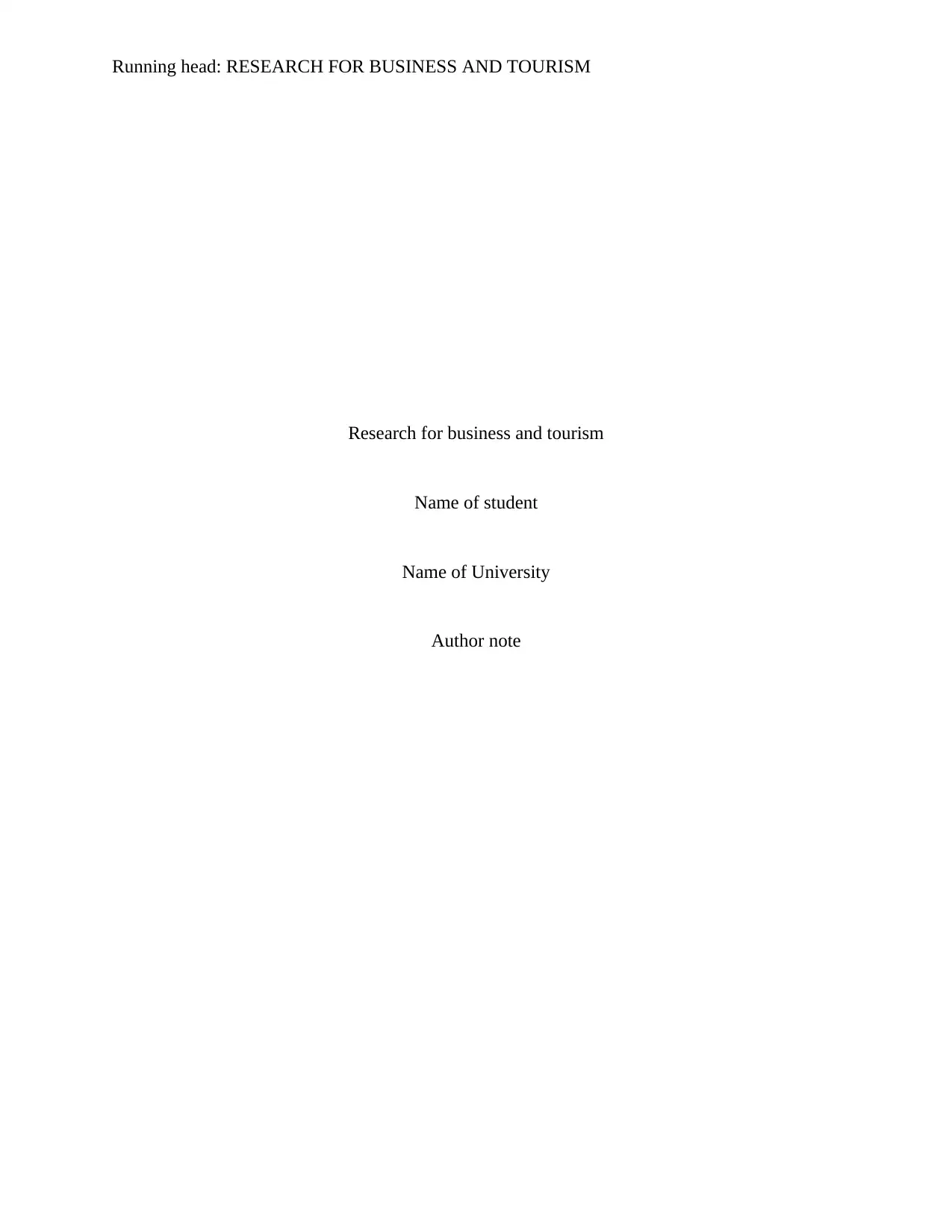
Running head: RESEARCH FOR BUSINESS AND TOURISM
Research for business and tourism
Name of student
Name of University
Author note
Research for business and tourism
Name of student
Name of University
Author note
Paraphrase This Document
Need a fresh take? Get an instant paraphrase of this document with our AI Paraphraser
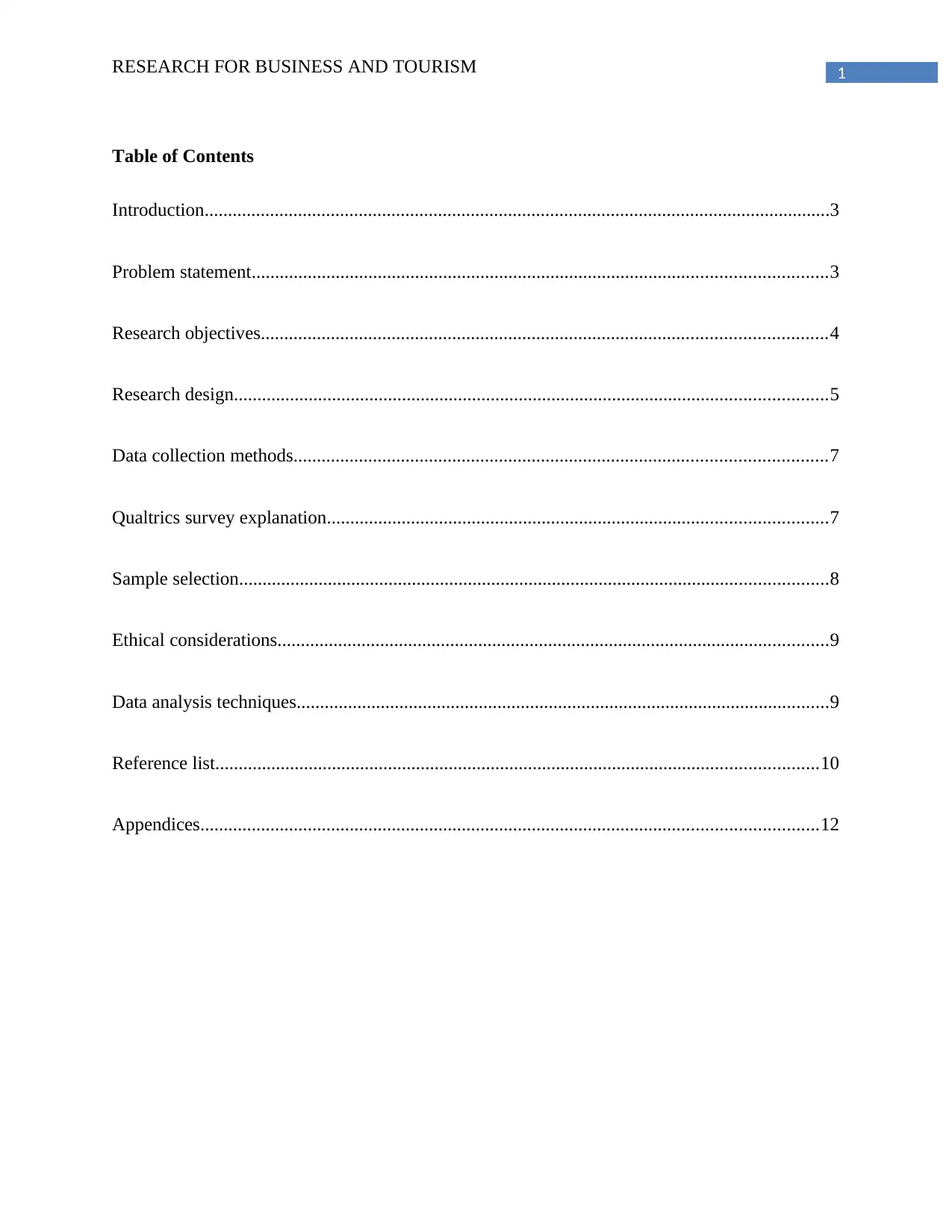
1RESEARCH FOR BUSINESS AND TOURISM
Table of Contents
Introduction......................................................................................................................................3
Problem statement...........................................................................................................................3
Research objectives.........................................................................................................................4
Research design...............................................................................................................................5
Data collection methods..................................................................................................................7
Qualtrics survey explanation...........................................................................................................7
Sample selection..............................................................................................................................8
Ethical considerations......................................................................................................................9
Data analysis techniques..................................................................................................................9
Reference list.................................................................................................................................10
Appendices....................................................................................................................................12
Table of Contents
Introduction......................................................................................................................................3
Problem statement...........................................................................................................................3
Research objectives.........................................................................................................................4
Research design...............................................................................................................................5
Data collection methods..................................................................................................................7
Qualtrics survey explanation...........................................................................................................7
Sample selection..............................................................................................................................8
Ethical considerations......................................................................................................................9
Data analysis techniques..................................................................................................................9
Reference list.................................................................................................................................10
Appendices....................................................................................................................................12
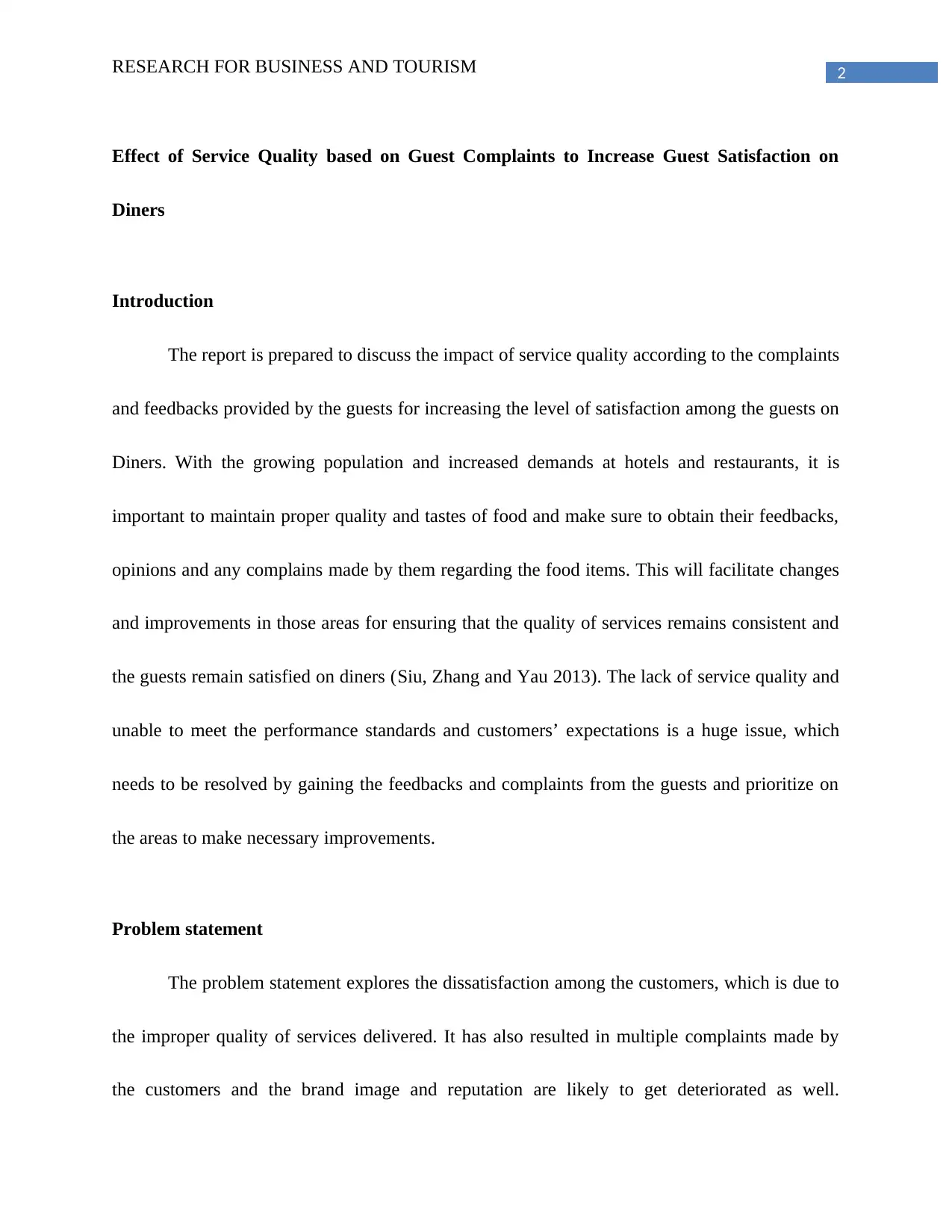
2RESEARCH FOR BUSINESS AND TOURISM
Effect of Service Quality based on Guest Complaints to Increase Guest Satisfaction on
Diners
Introduction
The report is prepared to discuss the impact of service quality according to the complaints
and feedbacks provided by the guests for increasing the level of satisfaction among the guests on
Diners. With the growing population and increased demands at hotels and restaurants, it is
important to maintain proper quality and tastes of food and make sure to obtain their feedbacks,
opinions and any complains made by them regarding the food items. This will facilitate changes
and improvements in those areas for ensuring that the quality of services remains consistent and
the guests remain satisfied on diners (Siu, Zhang and Yau 2013). The lack of service quality and
unable to meet the performance standards and customers’ expectations is a huge issue, which
needs to be resolved by gaining the feedbacks and complaints from the guests and prioritize on
the areas to make necessary improvements.
Problem statement
The problem statement explores the dissatisfaction among the customers, which is due to
the improper quality of services delivered. It has also resulted in multiple complaints made by
the customers and the brand image and reputation are likely to get deteriorated as well.
Effect of Service Quality based on Guest Complaints to Increase Guest Satisfaction on
Diners
Introduction
The report is prepared to discuss the impact of service quality according to the complaints
and feedbacks provided by the guests for increasing the level of satisfaction among the guests on
Diners. With the growing population and increased demands at hotels and restaurants, it is
important to maintain proper quality and tastes of food and make sure to obtain their feedbacks,
opinions and any complains made by them regarding the food items. This will facilitate changes
and improvements in those areas for ensuring that the quality of services remains consistent and
the guests remain satisfied on diners (Siu, Zhang and Yau 2013). The lack of service quality and
unable to meet the performance standards and customers’ expectations is a huge issue, which
needs to be resolved by gaining the feedbacks and complaints from the guests and prioritize on
the areas to make necessary improvements.
Problem statement
The problem statement explores the dissatisfaction among the customers, which is due to
the improper quality of services delivered. It has also resulted in multiple complaints made by
the customers and the brand image and reputation are likely to get deteriorated as well.
⊘ This is a preview!⊘
Do you want full access?
Subscribe today to unlock all pages.

Trusted by 1+ million students worldwide
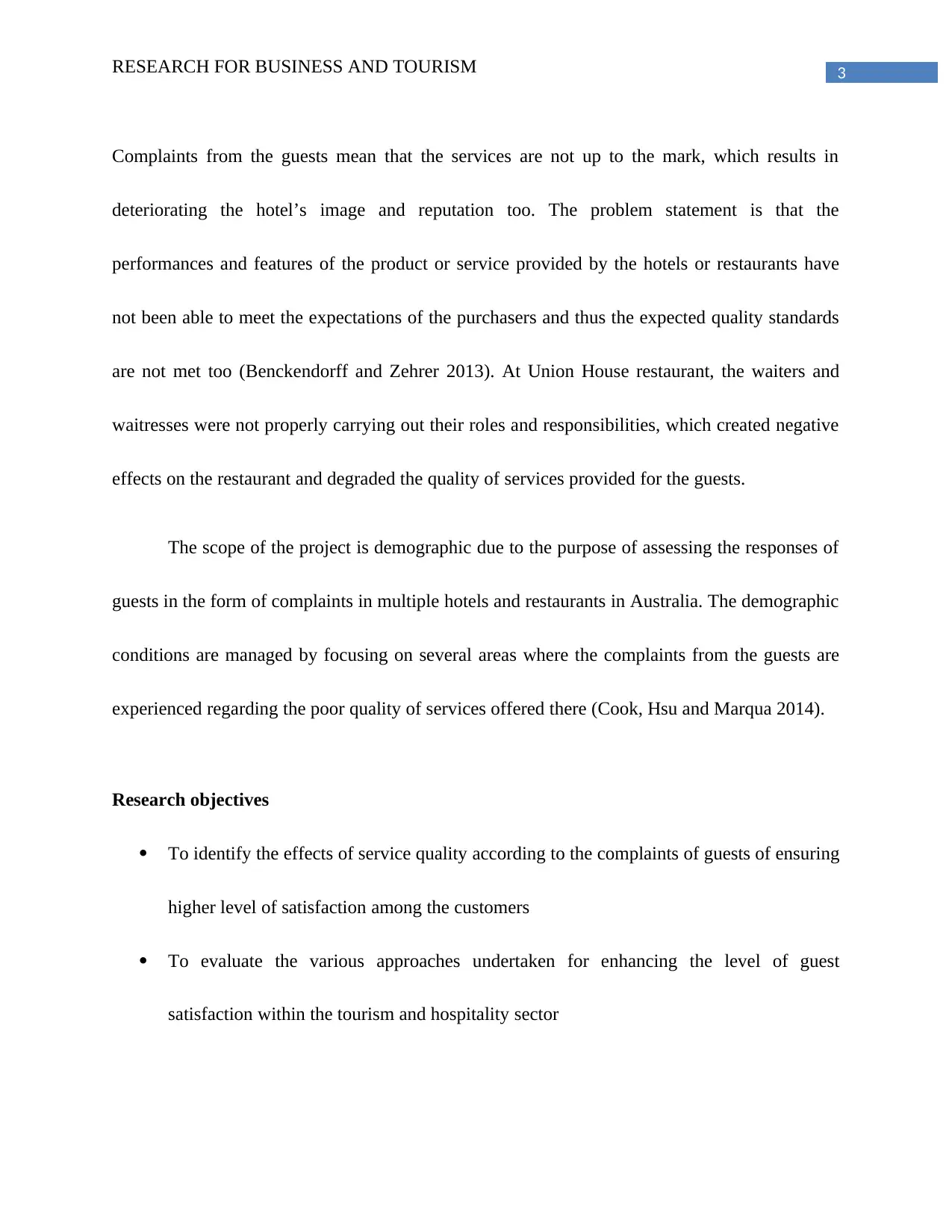
3RESEARCH FOR BUSINESS AND TOURISM
Complaints from the guests mean that the services are not up to the mark, which results in
deteriorating the hotel’s image and reputation too. The problem statement is that the
performances and features of the product or service provided by the hotels or restaurants have
not been able to meet the expectations of the purchasers and thus the expected quality standards
are not met too (Benckendorff and Zehrer 2013). At Union House restaurant, the waiters and
waitresses were not properly carrying out their roles and responsibilities, which created negative
effects on the restaurant and degraded the quality of services provided for the guests.
The scope of the project is demographic due to the purpose of assessing the responses of
guests in the form of complaints in multiple hotels and restaurants in Australia. The demographic
conditions are managed by focusing on several areas where the complaints from the guests are
experienced regarding the poor quality of services offered there (Cook, Hsu and Marqua 2014).
Research objectives
To identify the effects of service quality according to the complaints of guests of ensuring
higher level of satisfaction among the customers
To evaluate the various approaches undertaken for enhancing the level of guest
satisfaction within the tourism and hospitality sector
Complaints from the guests mean that the services are not up to the mark, which results in
deteriorating the hotel’s image and reputation too. The problem statement is that the
performances and features of the product or service provided by the hotels or restaurants have
not been able to meet the expectations of the purchasers and thus the expected quality standards
are not met too (Benckendorff and Zehrer 2013). At Union House restaurant, the waiters and
waitresses were not properly carrying out their roles and responsibilities, which created negative
effects on the restaurant and degraded the quality of services provided for the guests.
The scope of the project is demographic due to the purpose of assessing the responses of
guests in the form of complaints in multiple hotels and restaurants in Australia. The demographic
conditions are managed by focusing on several areas where the complaints from the guests are
experienced regarding the poor quality of services offered there (Cook, Hsu and Marqua 2014).
Research objectives
To identify the effects of service quality according to the complaints of guests of ensuring
higher level of satisfaction among the customers
To evaluate the various approaches undertaken for enhancing the level of guest
satisfaction within the tourism and hospitality sector
Paraphrase This Document
Need a fresh take? Get an instant paraphrase of this document with our AI Paraphraser
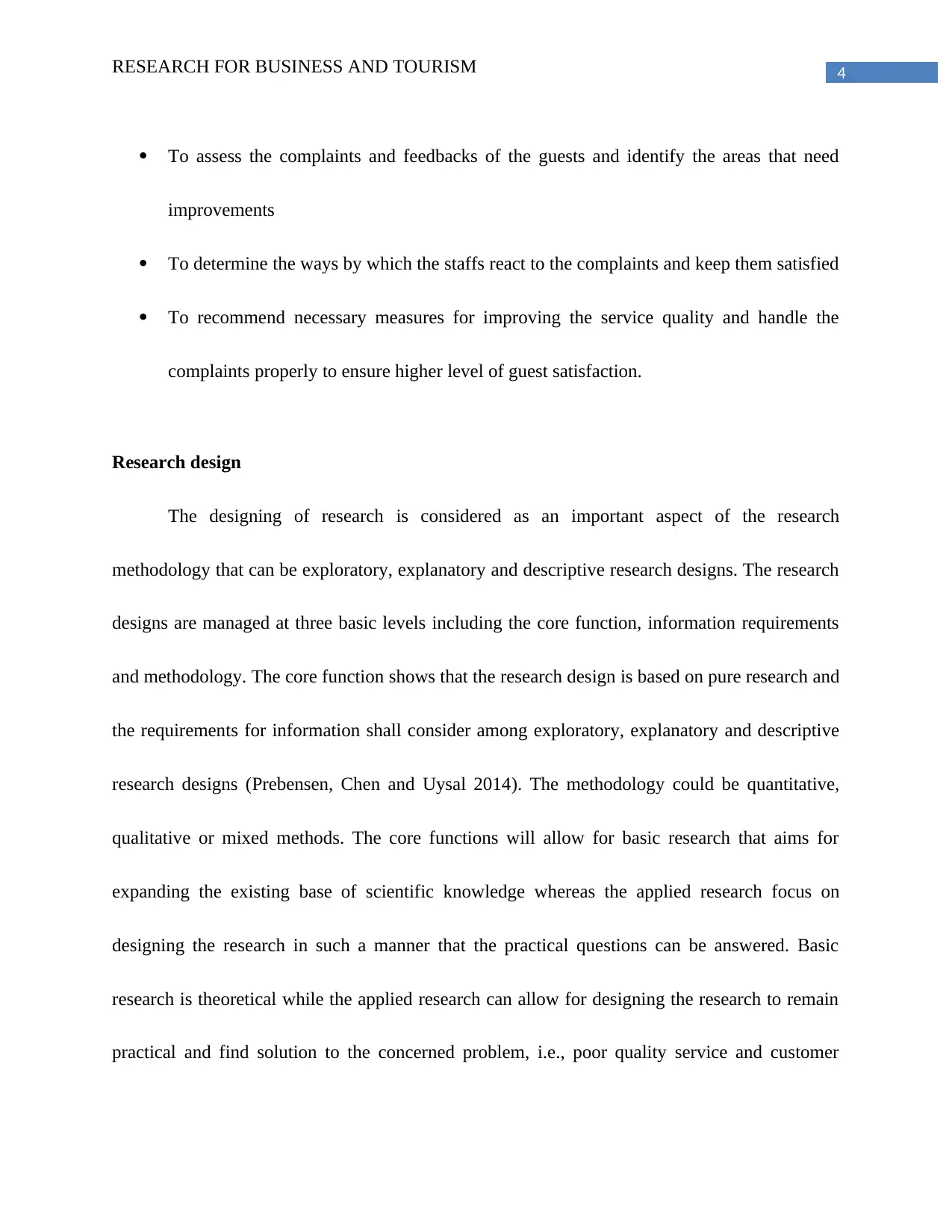
4RESEARCH FOR BUSINESS AND TOURISM
To assess the complaints and feedbacks of the guests and identify the areas that need
improvements
To determine the ways by which the staffs react to the complaints and keep them satisfied
To recommend necessary measures for improving the service quality and handle the
complaints properly to ensure higher level of guest satisfaction.
Research design
The designing of research is considered as an important aspect of the research
methodology that can be exploratory, explanatory and descriptive research designs. The research
designs are managed at three basic levels including the core function, information requirements
and methodology. The core function shows that the research design is based on pure research and
the requirements for information shall consider among exploratory, explanatory and descriptive
research designs (Prebensen, Chen and Uysal 2014). The methodology could be quantitative,
qualitative or mixed methods. The core functions will allow for basic research that aims for
expanding the existing base of scientific knowledge whereas the applied research focus on
designing the research in such a manner that the practical questions can be answered. Basic
research is theoretical while the applied research can allow for designing the research to remain
practical and find solution to the concerned problem, i.e., poor quality service and customer
To assess the complaints and feedbacks of the guests and identify the areas that need
improvements
To determine the ways by which the staffs react to the complaints and keep them satisfied
To recommend necessary measures for improving the service quality and handle the
complaints properly to ensure higher level of guest satisfaction.
Research design
The designing of research is considered as an important aspect of the research
methodology that can be exploratory, explanatory and descriptive research designs. The research
designs are managed at three basic levels including the core function, information requirements
and methodology. The core function shows that the research design is based on pure research and
the requirements for information shall consider among exploratory, explanatory and descriptive
research designs (Prebensen, Chen and Uysal 2014). The methodology could be quantitative,
qualitative or mixed methods. The core functions will allow for basic research that aims for
expanding the existing base of scientific knowledge whereas the applied research focus on
designing the research in such a manner that the practical questions can be answered. Basic
research is theoretical while the applied research can allow for designing the research to remain
practical and find solution to the concerned problem, i.e., poor quality service and customer
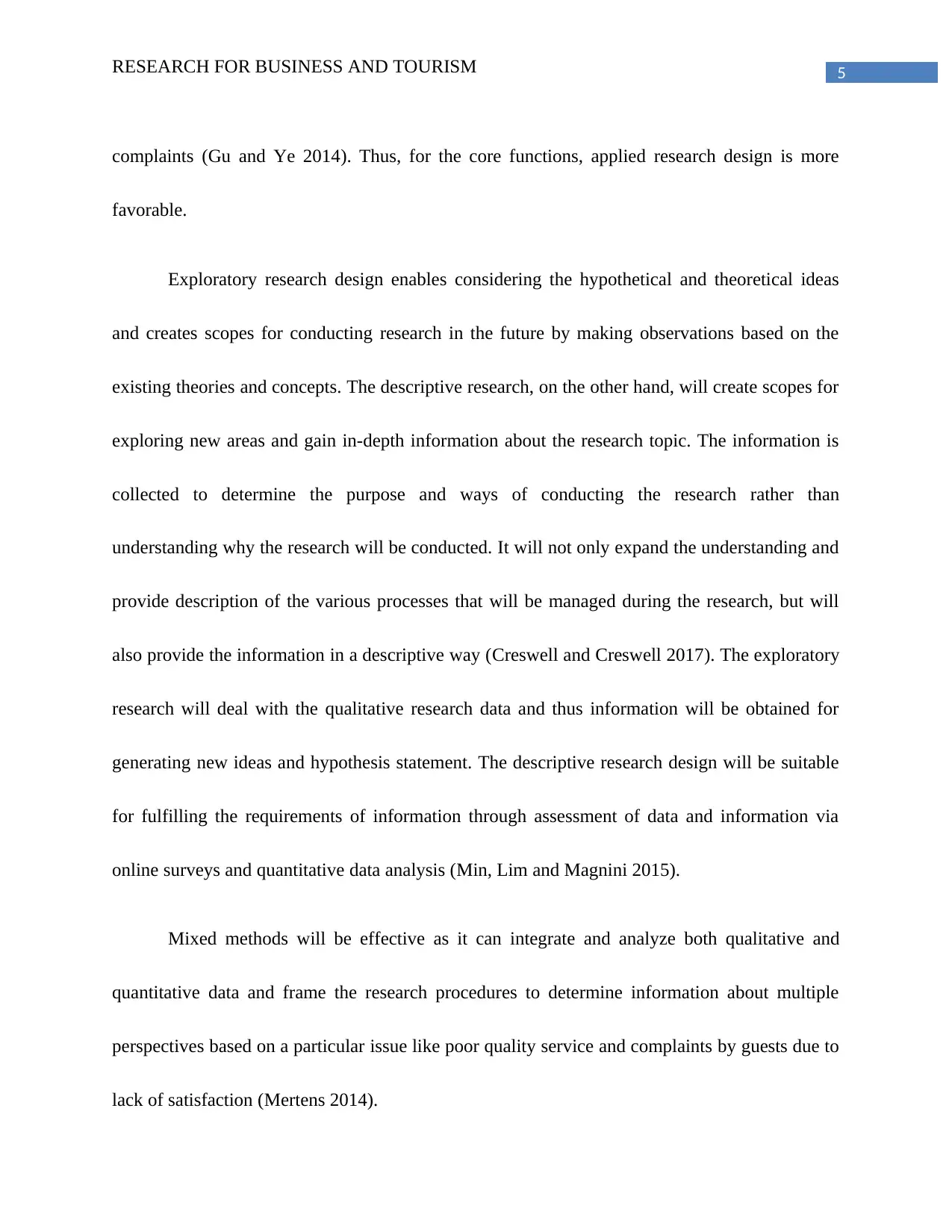
5RESEARCH FOR BUSINESS AND TOURISM
complaints (Gu and Ye 2014). Thus, for the core functions, applied research design is more
favorable.
Exploratory research design enables considering the hypothetical and theoretical ideas
and creates scopes for conducting research in the future by making observations based on the
existing theories and concepts. The descriptive research, on the other hand, will create scopes for
exploring new areas and gain in-depth information about the research topic. The information is
collected to determine the purpose and ways of conducting the research rather than
understanding why the research will be conducted. It will not only expand the understanding and
provide description of the various processes that will be managed during the research, but will
also provide the information in a descriptive way (Creswell and Creswell 2017). The exploratory
research will deal with the qualitative research data and thus information will be obtained for
generating new ideas and hypothesis statement. The descriptive research design will be suitable
for fulfilling the requirements of information through assessment of data and information via
online surveys and quantitative data analysis (Min, Lim and Magnini 2015).
Mixed methods will be effective as it can integrate and analyze both qualitative and
quantitative data and frame the research procedures to determine information about multiple
perspectives based on a particular issue like poor quality service and complaints by guests due to
lack of satisfaction (Mertens 2014).
complaints (Gu and Ye 2014). Thus, for the core functions, applied research design is more
favorable.
Exploratory research design enables considering the hypothetical and theoretical ideas
and creates scopes for conducting research in the future by making observations based on the
existing theories and concepts. The descriptive research, on the other hand, will create scopes for
exploring new areas and gain in-depth information about the research topic. The information is
collected to determine the purpose and ways of conducting the research rather than
understanding why the research will be conducted. It will not only expand the understanding and
provide description of the various processes that will be managed during the research, but will
also provide the information in a descriptive way (Creswell and Creswell 2017). The exploratory
research will deal with the qualitative research data and thus information will be obtained for
generating new ideas and hypothesis statement. The descriptive research design will be suitable
for fulfilling the requirements of information through assessment of data and information via
online surveys and quantitative data analysis (Min, Lim and Magnini 2015).
Mixed methods will be effective as it can integrate and analyze both qualitative and
quantitative data and frame the research procedures to determine information about multiple
perspectives based on a particular issue like poor quality service and complaints by guests due to
lack of satisfaction (Mertens 2014).
⊘ This is a preview!⊘
Do you want full access?
Subscribe today to unlock all pages.

Trusted by 1+ million students worldwide
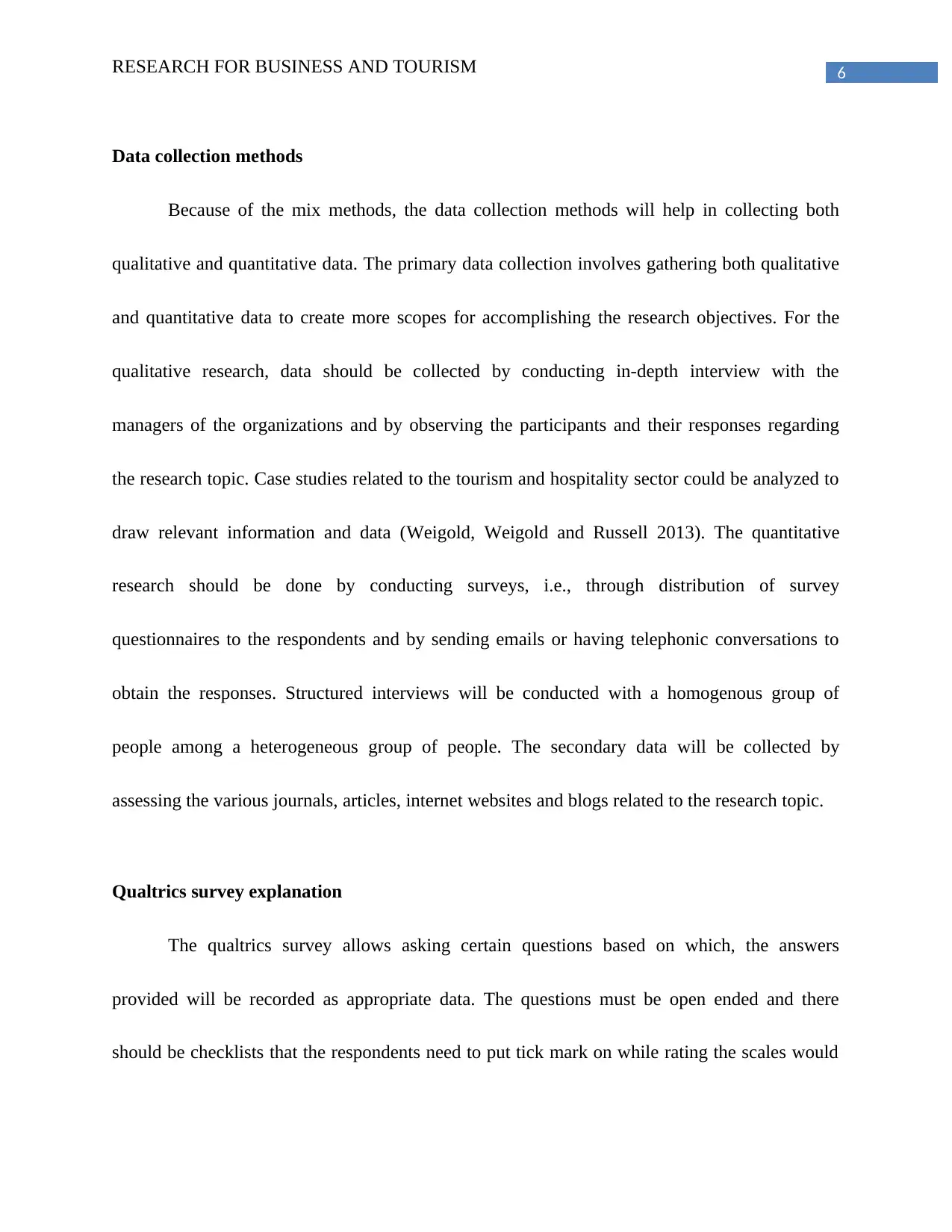
6RESEARCH FOR BUSINESS AND TOURISM
Data collection methods
Because of the mix methods, the data collection methods will help in collecting both
qualitative and quantitative data. The primary data collection involves gathering both qualitative
and quantitative data to create more scopes for accomplishing the research objectives. For the
qualitative research, data should be collected by conducting in-depth interview with the
managers of the organizations and by observing the participants and their responses regarding
the research topic. Case studies related to the tourism and hospitality sector could be analyzed to
draw relevant information and data (Weigold, Weigold and Russell 2013). The quantitative
research should be done by conducting surveys, i.e., through distribution of survey
questionnaires to the respondents and by sending emails or having telephonic conversations to
obtain the responses. Structured interviews will be conducted with a homogenous group of
people among a heterogeneous group of people. The secondary data will be collected by
assessing the various journals, articles, internet websites and blogs related to the research topic.
Qualtrics survey explanation
The qualtrics survey allows asking certain questions based on which, the answers
provided will be recorded as appropriate data. The questions must be open ended and there
should be checklists that the respondents need to put tick mark on while rating the scales would
Data collection methods
Because of the mix methods, the data collection methods will help in collecting both
qualitative and quantitative data. The primary data collection involves gathering both qualitative
and quantitative data to create more scopes for accomplishing the research objectives. For the
qualitative research, data should be collected by conducting in-depth interview with the
managers of the organizations and by observing the participants and their responses regarding
the research topic. Case studies related to the tourism and hospitality sector could be analyzed to
draw relevant information and data (Weigold, Weigold and Russell 2013). The quantitative
research should be done by conducting surveys, i.e., through distribution of survey
questionnaires to the respondents and by sending emails or having telephonic conversations to
obtain the responses. Structured interviews will be conducted with a homogenous group of
people among a heterogeneous group of people. The secondary data will be collected by
assessing the various journals, articles, internet websites and blogs related to the research topic.
Qualtrics survey explanation
The qualtrics survey allows asking certain questions based on which, the answers
provided will be recorded as appropriate data. The questions must be open ended and there
should be checklists that the respondents need to put tick mark on while rating the scales would
Paraphrase This Document
Need a fresh take? Get an instant paraphrase of this document with our AI Paraphraser
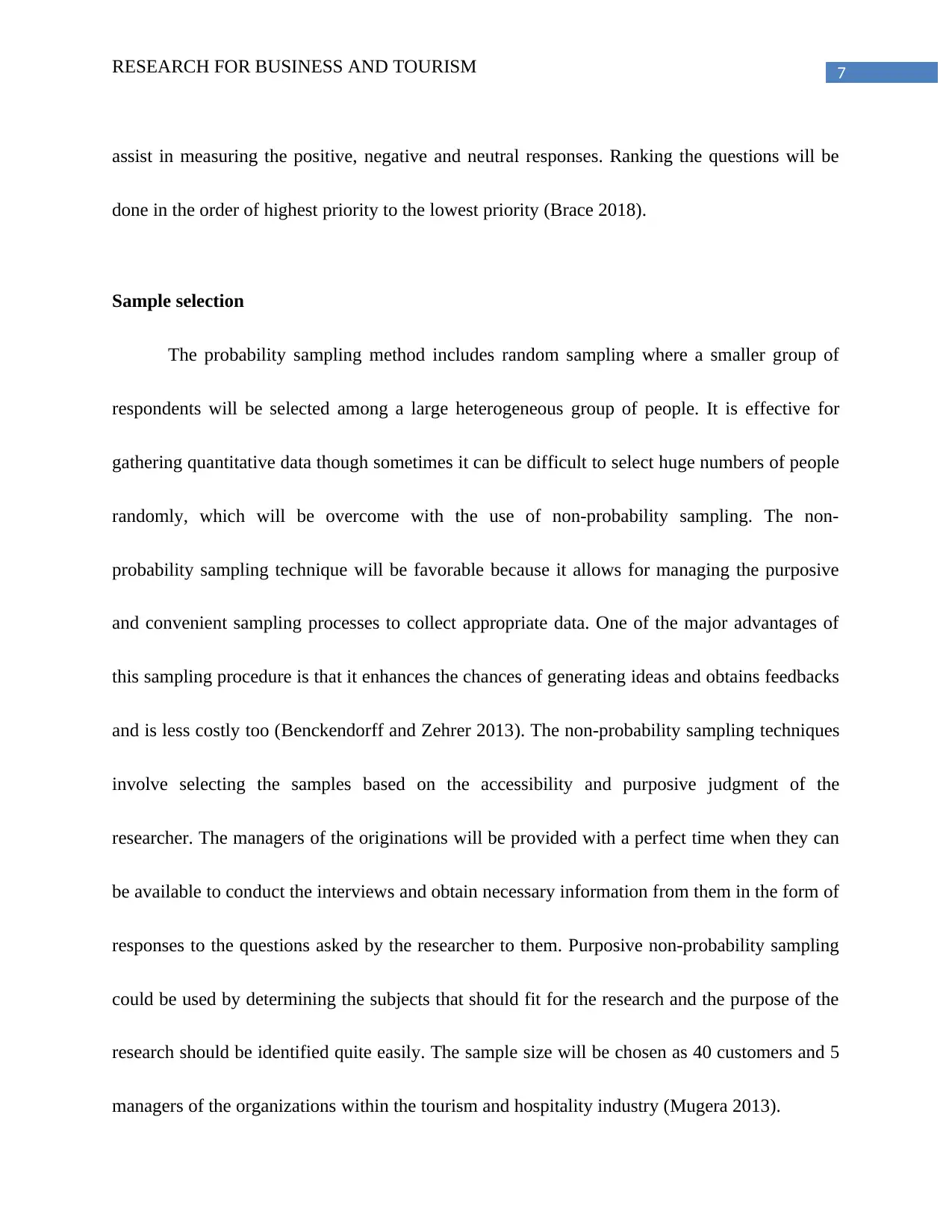
7RESEARCH FOR BUSINESS AND TOURISM
assist in measuring the positive, negative and neutral responses. Ranking the questions will be
done in the order of highest priority to the lowest priority (Brace 2018).
Sample selection
The probability sampling method includes random sampling where a smaller group of
respondents will be selected among a large heterogeneous group of people. It is effective for
gathering quantitative data though sometimes it can be difficult to select huge numbers of people
randomly, which will be overcome with the use of non-probability sampling. The non-
probability sampling technique will be favorable because it allows for managing the purposive
and convenient sampling processes to collect appropriate data. One of the major advantages of
this sampling procedure is that it enhances the chances of generating ideas and obtains feedbacks
and is less costly too (Benckendorff and Zehrer 2013). The non-probability sampling techniques
involve selecting the samples based on the accessibility and purposive judgment of the
researcher. The managers of the originations will be provided with a perfect time when they can
be available to conduct the interviews and obtain necessary information from them in the form of
responses to the questions asked by the researcher to them. Purposive non-probability sampling
could be used by determining the subjects that should fit for the research and the purpose of the
research should be identified quite easily. The sample size will be chosen as 40 customers and 5
managers of the organizations within the tourism and hospitality industry (Mugera 2013).
assist in measuring the positive, negative and neutral responses. Ranking the questions will be
done in the order of highest priority to the lowest priority (Brace 2018).
Sample selection
The probability sampling method includes random sampling where a smaller group of
respondents will be selected among a large heterogeneous group of people. It is effective for
gathering quantitative data though sometimes it can be difficult to select huge numbers of people
randomly, which will be overcome with the use of non-probability sampling. The non-
probability sampling technique will be favorable because it allows for managing the purposive
and convenient sampling processes to collect appropriate data. One of the major advantages of
this sampling procedure is that it enhances the chances of generating ideas and obtains feedbacks
and is less costly too (Benckendorff and Zehrer 2013). The non-probability sampling techniques
involve selecting the samples based on the accessibility and purposive judgment of the
researcher. The managers of the originations will be provided with a perfect time when they can
be available to conduct the interviews and obtain necessary information from them in the form of
responses to the questions asked by the researcher to them. Purposive non-probability sampling
could be used by determining the subjects that should fit for the research and the purpose of the
research should be identified quite easily. The sample size will be chosen as 40 customers and 5
managers of the organizations within the tourism and hospitality industry (Mugera 2013).
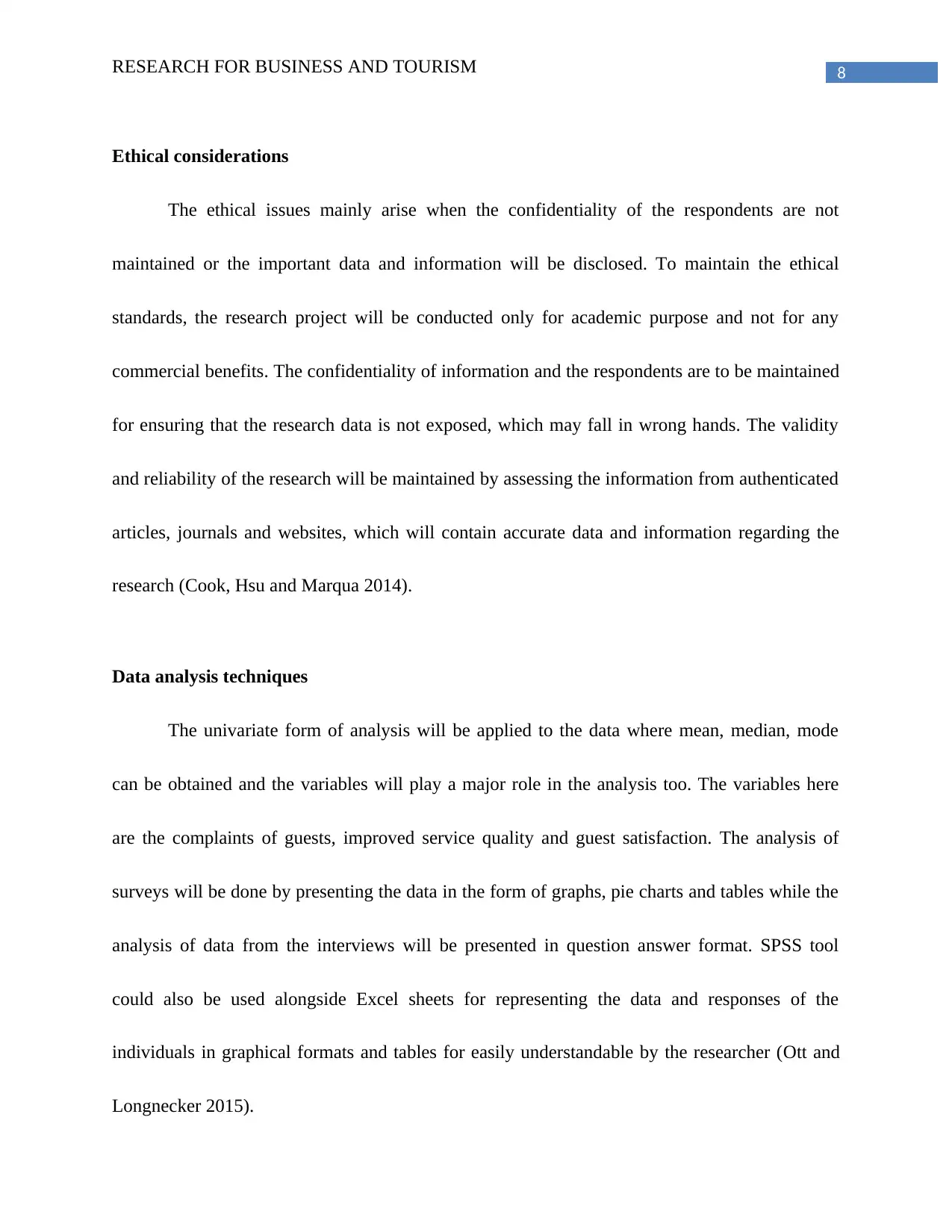
8RESEARCH FOR BUSINESS AND TOURISM
Ethical considerations
The ethical issues mainly arise when the confidentiality of the respondents are not
maintained or the important data and information will be disclosed. To maintain the ethical
standards, the research project will be conducted only for academic purpose and not for any
commercial benefits. The confidentiality of information and the respondents are to be maintained
for ensuring that the research data is not exposed, which may fall in wrong hands. The validity
and reliability of the research will be maintained by assessing the information from authenticated
articles, journals and websites, which will contain accurate data and information regarding the
research (Cook, Hsu and Marqua 2014).
Data analysis techniques
The univariate form of analysis will be applied to the data where mean, median, mode
can be obtained and the variables will play a major role in the analysis too. The variables here
are the complaints of guests, improved service quality and guest satisfaction. The analysis of
surveys will be done by presenting the data in the form of graphs, pie charts and tables while the
analysis of data from the interviews will be presented in question answer format. SPSS tool
could also be used alongside Excel sheets for representing the data and responses of the
individuals in graphical formats and tables for easily understandable by the researcher (Ott and
Longnecker 2015).
Ethical considerations
The ethical issues mainly arise when the confidentiality of the respondents are not
maintained or the important data and information will be disclosed. To maintain the ethical
standards, the research project will be conducted only for academic purpose and not for any
commercial benefits. The confidentiality of information and the respondents are to be maintained
for ensuring that the research data is not exposed, which may fall in wrong hands. The validity
and reliability of the research will be maintained by assessing the information from authenticated
articles, journals and websites, which will contain accurate data and information regarding the
research (Cook, Hsu and Marqua 2014).
Data analysis techniques
The univariate form of analysis will be applied to the data where mean, median, mode
can be obtained and the variables will play a major role in the analysis too. The variables here
are the complaints of guests, improved service quality and guest satisfaction. The analysis of
surveys will be done by presenting the data in the form of graphs, pie charts and tables while the
analysis of data from the interviews will be presented in question answer format. SPSS tool
could also be used alongside Excel sheets for representing the data and responses of the
individuals in graphical formats and tables for easily understandable by the researcher (Ott and
Longnecker 2015).
⊘ This is a preview!⊘
Do you want full access?
Subscribe today to unlock all pages.

Trusted by 1+ million students worldwide
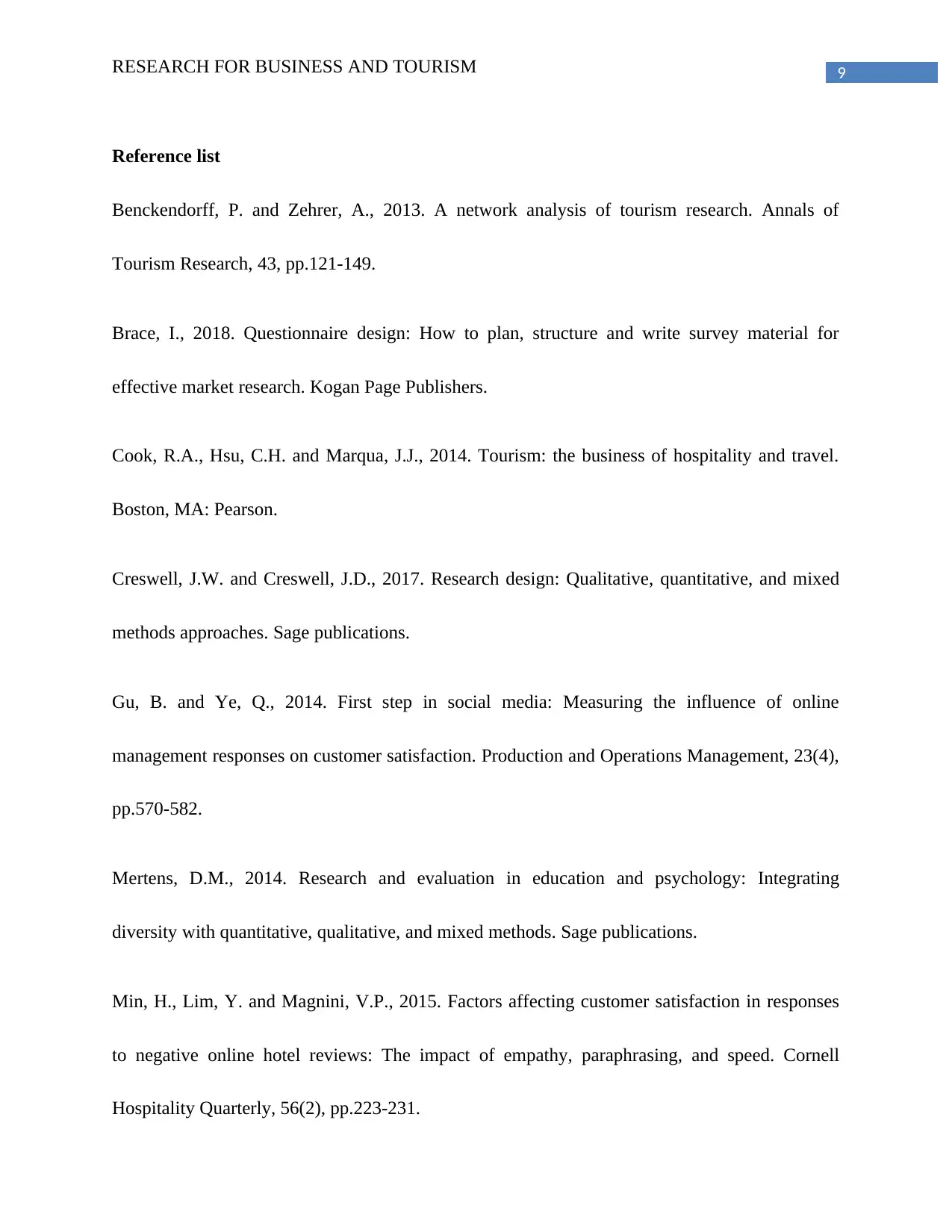
9RESEARCH FOR BUSINESS AND TOURISM
Reference list
Benckendorff, P. and Zehrer, A., 2013. A network analysis of tourism research. Annals of
Tourism Research, 43, pp.121-149.
Brace, I., 2018. Questionnaire design: How to plan, structure and write survey material for
effective market research. Kogan Page Publishers.
Cook, R.A., Hsu, C.H. and Marqua, J.J., 2014. Tourism: the business of hospitality and travel.
Boston, MA: Pearson.
Creswell, J.W. and Creswell, J.D., 2017. Research design: Qualitative, quantitative, and mixed
methods approaches. Sage publications.
Gu, B. and Ye, Q., 2014. First step in social media: Measuring the influence of online
management responses on customer satisfaction. Production and Operations Management, 23(4),
pp.570-582.
Mertens, D.M., 2014. Research and evaluation in education and psychology: Integrating
diversity with quantitative, qualitative, and mixed methods. Sage publications.
Min, H., Lim, Y. and Magnini, V.P., 2015. Factors affecting customer satisfaction in responses
to negative online hotel reviews: The impact of empathy, paraphrasing, and speed. Cornell
Hospitality Quarterly, 56(2), pp.223-231.
Reference list
Benckendorff, P. and Zehrer, A., 2013. A network analysis of tourism research. Annals of
Tourism Research, 43, pp.121-149.
Brace, I., 2018. Questionnaire design: How to plan, structure and write survey material for
effective market research. Kogan Page Publishers.
Cook, R.A., Hsu, C.H. and Marqua, J.J., 2014. Tourism: the business of hospitality and travel.
Boston, MA: Pearson.
Creswell, J.W. and Creswell, J.D., 2017. Research design: Qualitative, quantitative, and mixed
methods approaches. Sage publications.
Gu, B. and Ye, Q., 2014. First step in social media: Measuring the influence of online
management responses on customer satisfaction. Production and Operations Management, 23(4),
pp.570-582.
Mertens, D.M., 2014. Research and evaluation in education and psychology: Integrating
diversity with quantitative, qualitative, and mixed methods. Sage publications.
Min, H., Lim, Y. and Magnini, V.P., 2015. Factors affecting customer satisfaction in responses
to negative online hotel reviews: The impact of empathy, paraphrasing, and speed. Cornell
Hospitality Quarterly, 56(2), pp.223-231.
Paraphrase This Document
Need a fresh take? Get an instant paraphrase of this document with our AI Paraphraser
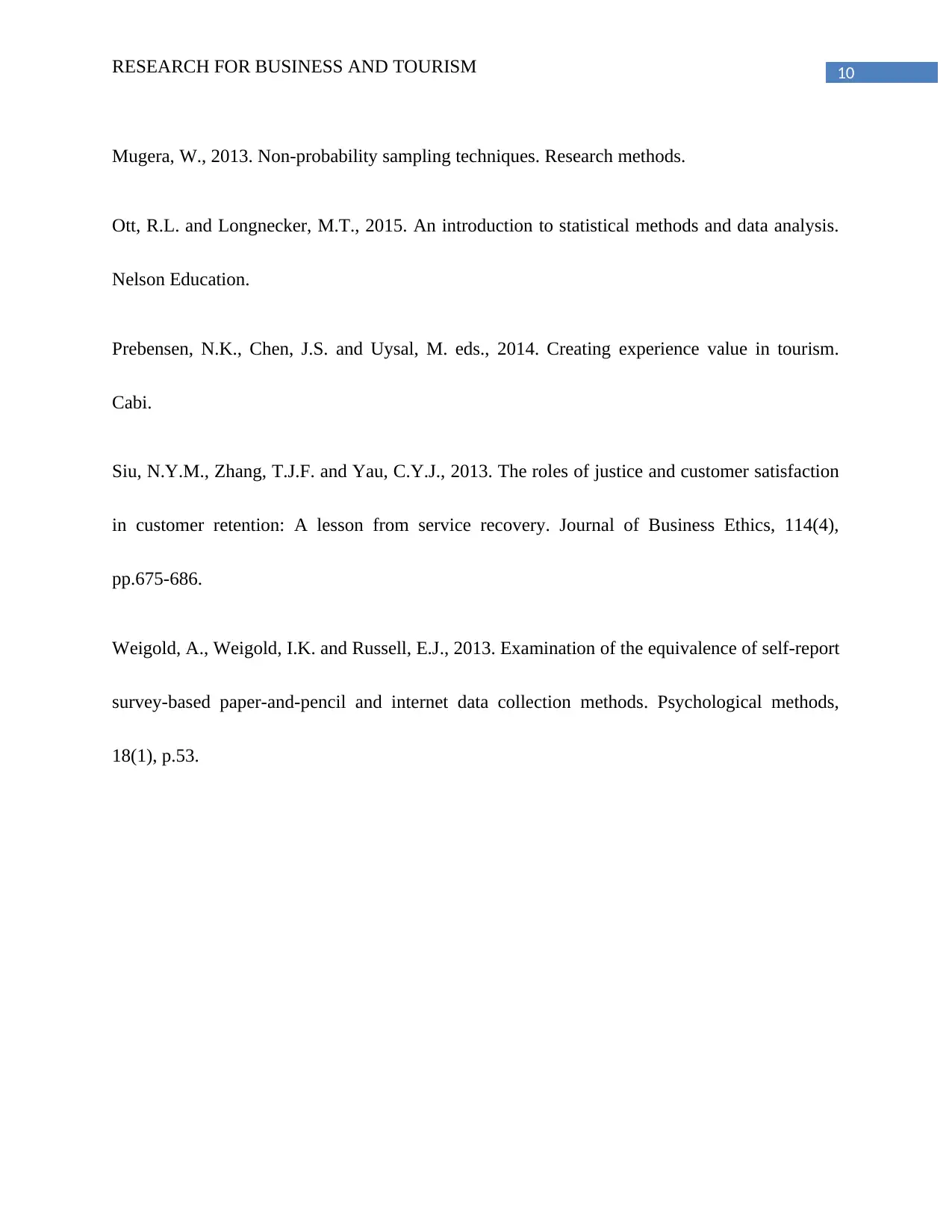
10RESEARCH FOR BUSINESS AND TOURISM
Mugera, W., 2013. Non-probability sampling techniques. Research methods.
Ott, R.L. and Longnecker, M.T., 2015. An introduction to statistical methods and data analysis.
Nelson Education.
Prebensen, N.K., Chen, J.S. and Uysal, M. eds., 2014. Creating experience value in tourism.
Cabi.
Siu, N.Y.M., Zhang, T.J.F. and Yau, C.Y.J., 2013. The roles of justice and customer satisfaction
in customer retention: A lesson from service recovery. Journal of Business Ethics, 114(4),
pp.675-686.
Weigold, A., Weigold, I.K. and Russell, E.J., 2013. Examination of the equivalence of self-report
survey-based paper-and-pencil and internet data collection methods. Psychological methods,
18(1), p.53.
Mugera, W., 2013. Non-probability sampling techniques. Research methods.
Ott, R.L. and Longnecker, M.T., 2015. An introduction to statistical methods and data analysis.
Nelson Education.
Prebensen, N.K., Chen, J.S. and Uysal, M. eds., 2014. Creating experience value in tourism.
Cabi.
Siu, N.Y.M., Zhang, T.J.F. and Yau, C.Y.J., 2013. The roles of justice and customer satisfaction
in customer retention: A lesson from service recovery. Journal of Business Ethics, 114(4),
pp.675-686.
Weigold, A., Weigold, I.K. and Russell, E.J., 2013. Examination of the equivalence of self-report
survey-based paper-and-pencil and internet data collection methods. Psychological methods,
18(1), p.53.
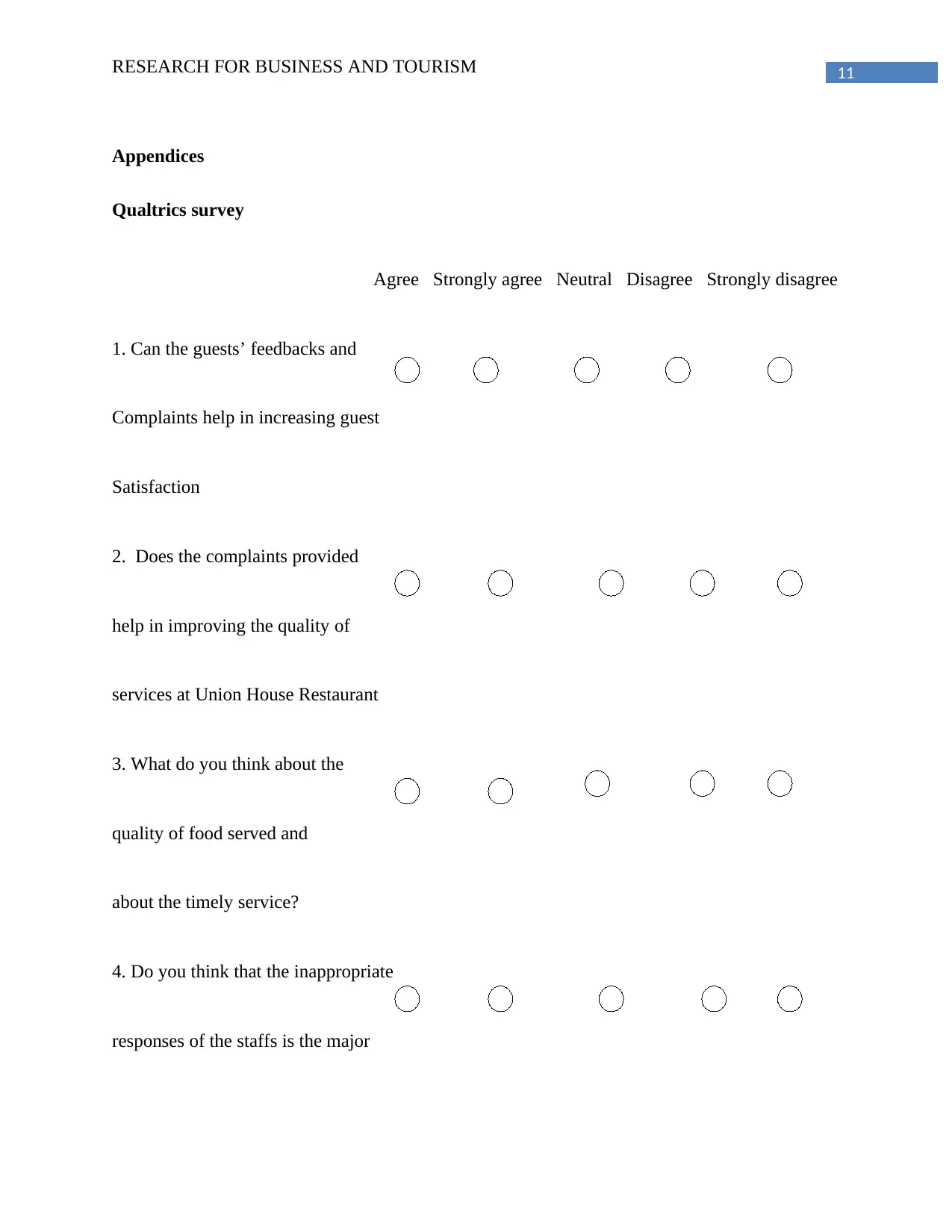
11RESEARCH FOR BUSINESS AND TOURISM
Appendices
Qualtrics survey
Agree Strongly agree Neutral Disagree Strongly disagree
1. Can the guests’ feedbacks and
Complaints help in increasing guest
Satisfaction
2. Does the complaints provided
help in improving the quality of
services at Union House Restaurant
3. What do you think about the
quality of food served and
about the timely service?
4. Do you think that the inappropriate
responses of the staffs is the major
Appendices
Qualtrics survey
Agree Strongly agree Neutral Disagree Strongly disagree
1. Can the guests’ feedbacks and
Complaints help in increasing guest
Satisfaction
2. Does the complaints provided
help in improving the quality of
services at Union House Restaurant
3. What do you think about the
quality of food served and
about the timely service?
4. Do you think that the inappropriate
responses of the staffs is the major
⊘ This is a preview!⊘
Do you want full access?
Subscribe today to unlock all pages.

Trusted by 1+ million students worldwide
1 out of 13
Related Documents
Your All-in-One AI-Powered Toolkit for Academic Success.
+13062052269
info@desklib.com
Available 24*7 on WhatsApp / Email
![[object Object]](/_next/static/media/star-bottom.7253800d.svg)
Unlock your academic potential
Copyright © 2020–2025 A2Z Services. All Rights Reserved. Developed and managed by ZUCOL.




